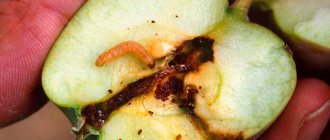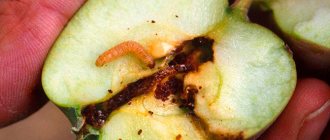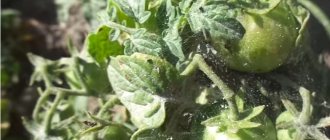White dots on wilting rose leaves indicate that the plant is infected with spider mites. It itself is barely visible to the naked eye (up to 0.6 mm). If you strain your eyes, then on the back side of the leaf blade you can see clusters of sedentary orange, brownish or dirty white bugs sucking juices from the leaves.
An infected plant needs urgent treatment, since the parasites multiply and feed very intensively. The appearance of a web means that the colony has reached a large size.
Description of the pest. Features of life
The body length of the pest varies depending on the variety. For example, the common spider mite reaches 0.6 mm in length. Females are larger; for comparison, the body size of males does not exceed 0.45 mm. Externally, mites resemble microscopic spiders. This is due to the presence of 4 pairs of limbs, the absence of antennae, like insects, and a large mouthparts.
The body of the spider mite is oval and convex. The color differs depending on what species the pests belong to. In addition, the color of the body of the parasite depends on the stage of development: green, yellowish, brown, red. For example, at the initial stage of the life cycle, the spider mite is green, but as autumn approaches, its body darkens and the outer coverings become brown.
This allows the pest
adapt to environmental conditions.
Mite webs can be seen not only on the leaves, but also on the stems of the rose.
Ticks become active when the air temperature rises in the spring after the end of winter. They immediately begin to feed. Parasites need this to gain energy for further reproduction. The life cycle lasts several weeks, depending on environmental conditions. The cellular fluid of plants acts as a source of food.
Pests leave eggs on the underside of leaves. When the larvae emerge from the shells, they also begin to feed. The life cycle of parasites consists of several stages. First, the egg appears, then the larva, nymph, and imago (mature individual). In 1 season, when the temperature is maintained at more than 20°C, from 9 to 12 generations of spider mites appear.
As the parasite feeds
There is a wilting of the rose, a decrease in its decorative qualities.
Spider mites generally begin their activity in the spring.
What is a tick
Spider mites belong to the category of arthropods, therefore, strictly speaking, they cannot be classified as insects. The size of the mite is very small, it is difficult to see it with the naked eye, only when looking closely at the rose bushes can you notice small bugs, the size of a grain of sand. This is a tick. Females are usually larger than males, measuring about 0.4-0.6 mm, while the body of males is 0.2-0.4 mm long. Sometimes the adult size can reach up to 1 mm, but such mites are rare.
Spider mite
The color of the pest is bright red, less often orange or yellow, which makes it difficult to detect on rose flowers of red and burgundy shades. When the colony becomes too numerous, they become noticeable on the bush due to their bright color. Mite larvae are light green and are also difficult to find on the inside of the leaf.
Spider mites reproduce quite quickly, as if compensating for the fact that not all individuals survive the winter. A female tick is capable of laying up to 400 eggs in one clutch; over the summer there can be more than 20 such clutches. The larvae in the egg mature within 10-14 days, after which the larva is born and passes into the nymphal stage. After several molts, the larva turns into an adult. Larvae have three pairs of legs, nymphs and adults have 4 pairs each. The lifespan of the parasite is relatively short - only one and a half to two months, but even during this period they are capable of causing severe damage to plantings on the site.
Spider mite larvae
Ideal conditions for living and active reproduction of mites are low humidity (less than 50%) and high temperature (25-35 degrees), so rainy weather or a sudden cold snap can help in the fight against spider mites.
Insects often overwinter in fallen leaves, cracks in the bark, on weeds, and unharvested old bushes, but not all individuals survive. You can also infect healthy plants by planting infected bushes next to them.
Arthropods spread throughout the area with the help of larger insects, birds, animals; strong wind also contributes to the spread. Spider mites can get onto indoor flowers from the street, for example through a window. Spider mites produce webs, with the help of which they also “travel.”
Spider mite on a rose
The insect settles on both home and garden flowers. The mite attacks various plants, but most of all it loves strong and juicy roses. The difficulty of eliminating the parasite is that it develops rapidly, and although its lifespan is short, up to 1 month, during this time the female manages to lay thousands of eggs.
How does a mite get on a flower?
The carrier of mites is the wind, which carries them from one plant to another.
Spider mites are one of the most destructive insects for roses.
The insect is carried into the apartment on shoes and items of clothing, and with the wind - through windows.
Prevention
Proper care and regular prevention are the key to plant health. To ensure rose protection from spider mites, following these recommendations will help:
- purchased flowers should be kept separate from other plants for 10–15 days;
- periodically you need to spray indoor roses with water from a spray bottle, and wash garden roses with a hose;
- promptly remove faded buds and dried leaves;
- Maintain a sufficient level of humidity in the room where the roses are located.
In addition, it is necessary to inspect the plants from time to time for the presence of mites.
Consequences of the life activity of spider mites. Signs of defeat
The main danger for indoor roses is drying out. This is facilitated by the parasitism of spider mites. The more arthropods live on a flower, the faster its death occurs. When the spider mite inserts its mouthparts into the plant tissue, the chloroplasts are destroyed, which leads to the appearance of pigmentation (first light spots are detected, then brown spots). Here the process of photosynthesis is disrupted and there is a lack of chlorophyll.
Before death comes,
the rose stops developing, it does not bloom, and loses its attractiveness.
Other signs of infection:
- leaf deformation;
- detection of small dots on the back of the leaves - these are pest eggs; the mite constantly parasitizes roses, so it leaves offspring here;
- if the infection is severe, a cobweb appears; it is possible to save the plant if the leaves are still green under the thin threads; when most of the bush has already dried up, the home flower must be destroyed.
Additional events
You should always monitor the condition of the flowers and take immediate action at the slightest sign of infection. If a parasite is noticed on a plant, it is necessary to rinse it with warm running water, and then wipe the leaves with a low concentration alcohol solution.
Next, you need to choose the most suitable product and treat the rose. Remember that you will also need to treat the window sill and the area where the flowerpots are located. The procedure must be repeated after a week. In order to protect the rose, fertilizer with potassium is applied after the repeated procedure.
Signs of a mite on a rose
The main sign of the appearance of spider mites on house flowers is the presence of a thin web that connects the leaves. Also, the presence of an insect is revealed by a large number of small dots, which are larvae. If you do not start a fight, then soon the plant will be completely entwined with cobwebs, in which you will find many bugs.
The mite feeds on plant sap and sucks it out of the cells, which is why white spots appear on the leaves. Damaged cells die, vital processes in the leaves are disrupted and the plant weakens and becomes unstable to various diseases. It is very difficult to treat such a plant. First of all, young shoots are affected.
A few words about the pest
The spider mite is a small oval-shaped arachnid insect, 1 millimeter in size, red in color (the larvae are light green).
Plant sap is the main food of the pest. The insect is an omnivore; it attacks absolutely all plants it comes across on its way. Can be transported over long distances using its web. At air temperatures above +23 degrees, the mite multiplies quickly, laying up to several hundred eggs on the leaves. The larvae are particularly gluttonous - they drink plant juice. In this case, the process of photosynthesis is disrupted, the plant is depleted and dies. Attention!
Spider mites most often attack young bushes that do not have strong immunity. When exposed to the pest, such bushes do not have time to form buds.
The result of the activity of a spider mite
If the number is small, the pests will not bother you much, but if the ambient temperature is high for a long time, the spider mites will multiply very quickly and after some time they will seriously damage the rose. Since they feed on plant juices, they are quickly depleted and, as a result, instead of strengthening their root system, they devote all their energy to replenishing nutrients. The foliage begins to gradually become covered with black dots, then turns yellow and falls off.
Spider mites often settle not only on the leaves, but also on the stem and buds. In these areas you will also find a thin web with tiny grains of sand moving underneath it. And if you do not take the necessary control measures in time, you can lose most of the rose bushes.
On a note! Spider mites are most dangerous for young seedlings. And if the damage from the parasite is aggravated by a dry climate and poor watering, then the young roses will not even have time to form healthy buds!
Diseases and pests
If a rose's leaves gradually turn yellow and fall off, the cause is often diseases and parasites. A similar reaction occurs due to fungal diseases. In this case, it is recommended to remove the damaged parts of the bush as soon as possible. But fungus - for example, black spotting - is not the most terrible disease. If the rose has suffered from a viral disease, it, unfortunately, will need to be removed from the site and then destroyed. Otherwise, there is a high probability that your other garden flowers will die.
As for black spot, it is enough to purchase a high-quality fungicide and spray the bush. If possible, do this again, but for preventive purposes. Another important point: not only diseases harm the health of your plant. Sometimes yellowing and withering leaves are the result of an invasion of various insects. The sooner you detect such a problem, the faster you can get rid of it. An ordinary insecticide will help to do this.
Spider mites on roses. How to fight
Both chemical methods and folk methods passed down from generation to generation will help you in the fight against the parasite. The proportions and calculations of the drug are based on the degree of damage.
Chemical methods of control
In cases of global pest damage, preference is given to modern control methods or, in other words, acaricides, which in turn can be divided into:
- Specific ones are used and act directly on spider mites. This subgroup may have different compositions, but they begin to work against the pest only with direct contact.
- Insectoacaricides are used to destroy all pests that have invaded and affected the rose.
Here are the most commonly used drugs.
- A drug that attacks the pest through the digestive system is Actellik . This treatment has a lasting effect of protection and destruction of ticks lasting from one to two weeks. For a more lasting result, Actellik is applied twice with a seven-day interval between each other. It is not recommended to use on roses grown at home or indoors due to the high level of toxicity. But in open spaces its effectiveness is quite high. The preparation of the composition for treatment is as follows: a 2 ml ampoule is dissolved in a liter of water. The entire visible surface of the rose and, in larger quantities, the back side of the leaves are sprayed with the prepared composition.
- "Apollo" has different effects on eggs, larvae, lymph and adults. The first ones kill. The latter are deprived of the opportunity to reproduce due to their complete sterilization. The effect of the drug is more persistent and lasting, unlike the previous one. It will provide your roses with protection for up to three months. The main substance that affects spider mites is clofentesine. The plants are treated with the finished composition in two stages with a break of a week. One Apollo ampoule contains 2 ml and is diluted in five liters of warm water.
- The drug "Floromite" affects spider mites in the stage of active growth and development. The function of destroying the pest in this product is performed by its main component biphenazate. The main advantage of Floromite is its speed of action; after 2-3 hours the parasite will not be able to harm your roses. You will be able to evaluate the full result in 4 days. Since only after this time the final effect of the treatment will be achieved and will remain unchanged for three weeks. Treatment with the prepared solution is carried out twice at intervals of a week. Method of application: spraying. Method of dilution: dilute 2 ml of Floromite in 5 liters of water. Having chosen this drug for protection, strictly follow the instructions included with it, otherwise the parasite will develop a strong immunity to it.
- "Fitoverm" in comparison with other compositions is applicable to roses grown indoors. Its main component is not a chemical, but a natural soil fungus. Also, for a lasting treatment result, the finished composition (2 ml per 1.25 liters of water) is applied more often and more, 3-4 times with a seven-day break between each treatment.
When choosing chemicals to protect roses, remember that everything should be within reasonable limits.
Firstly, most of these products destroy absolutely all insects, and this may not be necessary.
Secondly, due to constant spraying, the leaves will increase the nitrogen content. And for spider mites this will be a favorable environment.
To prevent ticks from developing stable immunity to drugs, simply change them periodically.
Fitoverm
A brand that has earned the trust of consumers. The preparations in the series have been produced since the 90s of the last century; they are distinguished by a wide range of insecticidal effects on many insects, including spider mites.
The active active component in Fitoverm is aversectin S. It causes paralysis of parasites and leads to their death.
For use in indoor floriculture, the drug is available in convenient glass ampoules. Fitoverm is used for spraying plants or uniformly wetting leaves.
Mites sucking rose juices stop feeding within 10 hours after treatment and die within 3 days.
For the greatest effect, it is recommended to spray the rose at night, since the active component of the drug disintegrates under the influence of sunlight.
The solution is prepared by diluting 2.5 mg of the chemical with 1.25 liters of water. To rid the rose of parasites forever, treatments are repeated three times at intervals of 7 days.
Aktellik
Another effective insecticide with a wide-spectrum effect on sucking insects with the active component pirimiphos-methyl is Actellik.
It is a low-toxic drug for mammals. It has a contact and intestinal effect on ticks. Insects die after treatment within a few hours; repeated spraying is done a week after the initial one.
Apollo
An effective drug against a whole range of pests of domestic plants with the active ingredient clofentizine.
Apollo allows you to destroy mites at the egg stage, while adult insects cease to be fertile and lose their ability to reproduce.
The protective effect is extended up to 3 months, the treatment is repeated for greater effectiveness a week after the first, dissolving one ampoule of the product in 5 liters of water.
Floromite
When looking for how to treat a rose against spider mites, you should pay attention to this drug.
Its active component is biphenazate, which destroys insects at the stage of maturity.
Carry out no more than 2 treatments with an interval of 2 weeks. Preparation of the solution involves dissolving 2 ml (ampoule) of Flomit in 5 liters of water.
All chemically produced drugs, despite the manufacturer’s assurances of low toxicity for humans, can cause poisoning.
Symptoms such as headache, nausea and vomiting, dizziness and weakness require first aid to be provided to the victim:
- gastric lavage;
- acceptance of sorbents;
- contacting a medical facility.
When working with chemicals, do not use food-grade utensils, prepare solutions near food, smoke or eat during processing.
It is necessary to use personal protective equipment: gloves, a respirator, perform actions in safety glasses and clothing that prevent the solution from coming into contact with exposed skin.
Signs of an affected plant
It is possible to identify a plant that is infected by the following signs:
- the appearance of small black dots on the leaf blades (traces from the proboscis of the larvae);
- change in natural color to yellow;
- leaves rolled into a tube;
- slow growth and development of the bush;
- numerous webs;
- massive loss of leaves;
- reduction in the size of buds;
- affected by fungal diseases;
- painful condition.
Consequences of infection
If you don’t know how to get rid of spider mites on roses, then there is a high probability of losing the flower. Treatment should begin at the first sign of detection of the parasite. Among the consequences that will appear in the absence of spraying with chemicals or folk remedies are:
- Destruction of cells leading to deterioration of the process of photosynthesis. The result is a weakening of the flower.
- Loss of decorativeness. Green leaves quickly turn yellow, dry out, and the buds become smaller.
- The appearance of gray rot or other fungal disease. The pest is a common cause of the development of this disease. Since the insect feeds on the cell sap of the plant, its immunity decreases and the degree of susceptibility to parasitic individuals increases.
The sooner you start treating a rose affected by spider mites, the greater the chance of helping it recover quickly.
A cobweb appeared on the rose, what to do at home - folk methods
You can rid a plant of the parasite using folk methods and specialized purchased products. The first is preferred because they are safer. But recipes made from natural products show effectiveness only in the early stages, when the parasite colony is not yet too large.
Onion tincture
Pour 100 g of onion peel into 5 liters of hot water. Leave for 5 days, then strain. Spray the bushes generously. Repeat the procedure every 2 days until the tick is destroyed.
Garlic tincture
Garlic tincture, which will help eliminate the parasite from roses, can be prepared according to several recipes:
- Chop the garlic head and pour 10 liters of hot water into it. Use only after the liquid has cooled completely.
- Grate the garlic. Pour 50 g of the ingredient into 3 liters of water and place the container in a dark place. Infuse for 7 days. Strain. The resulting concentrate must be diluted before use - pour 60 g of the prepared solution into 10 liters of water.
- Finely chop the garlic head and pour in 10 liters of slightly warmed water. Leave for several hours, strain.
Additional Information. To enhance the effectiveness of garlic tincture, you can add crushed laundry soap to it.
Tobacco infusion
The mite does not tolerate the smell of tobacco and quickly retreats from plants if they are sprayed with a tobacco-based solution. The recipe for a useful tincture is as follows: 50 grams of dry tobacco powder are mixed with water and left for a day. Then the mixture is filtered and diluted again with water. The finished product is sprayed two or three times every 7-10 days.
Soap solution
A solution of laundry soap is one of the most popular and quite effective ways to eliminate any parasites on roses, including spider mites. Recipe:
- Grind a piece of laundry soap on a grater.
- Pour in water and shake the container well until foam forms.
- Apply the prepared solution to the bush through a spray bottle.
Recommendations for using a soap solution that will help increase its effectiveness:
- Instead of laundry soap, you can use tar soap.
- It is necessary to treat with the solution not only the green part of the bush, but also the stem, as well as the ground under the plant.
- After 4 hours, the white coating formed from the soap must be washed off with a stream of water and cover the plant with film for a day.
Note! When spraying the stem and soil, do not allow the soap solution to get on the root.
Dandelion infusion
Common dandelion has shown good effectiveness in the fight against spider mites.
The roots of the plant are used to kill the pest. The raw materials are suitable both fresh and dry (for example, pharmaceutical).
Grind about 30 g of roots with a meat grinder, pour in a liter of boiling water and let it brew for a couple of hours. The filtered decoction is sprayed on the mite-affected rose. The treatment is repeated as necessary until the symptoms of plant infection completely disappear.
Herbal infusions and decoctions
Decoction of tops. Potato and tomato tops also do a good job of exterminating the pest. To prepare the decoction, finely chop the tops (400 grams), pour boiling water over them, and boil over a fire for 30 minutes. Before spraying, the mixture is cooled, filtered and diluted with water in a ratio of 1:3. This product will not harm the flowers, even if used repeatedly throughout the growing season.
Dandelion infusion. The mite also lists dandelion as one of the most unpleasant odors, which benefits the gardener. Roses are sprayed with a mixture of 40 grams of medicinal dandelion and 1-2 liters of water. By the way, before the procedure, the solution should infuse for 5-6 hours.
Cyclamen decoction. A healthy decoction is prepared from 50 grams of flower roots. The roots are peeled and then boiled in a small amount of water for an hour. Then the substrate solution is filtered, and the resulting cloudy water is used to wipe the leaves and stems that have received the most severe damage. The procedure can be repeated 2-3 times with an interval of five days.
Infusion of yarrow. You need to take a kilogram of dry leaves of a medicinal plant, pour boiling water over it and let it brew for 3-4 days. The infusion should be light yellow in color with a tart odor characteristic of yarrow. Roses are treated with the prepared infusion every 7 days.
Infusion of henbane. A poisonous plant is like no other suitable for destroying a malicious pest. To prepare a life-saving infusion, you will need 1 kilogram of henbane, which is filled with water and left to infuse for about 10 hours. Then the infusion is filtered and grated soap is added. The resulting concentrate is diluted with 10 liters of water and only then the bushes are treated.
Horseradish infusion. The roots are finely chopped (one kilogram is enough), poured with cold water in a ratio of 1:10, left for several hours and the plants are watered.
Decoction of alder leaves. Fresh gray alder leaves (2 kilograms) are poured into cold water and left to brew for a day. Then the substrate is boiled over low heat, cooled and left to infuse again for 12 hours. The resulting mixture is filtered and poured into the soil in the flower garden.
Wormwood decoction. Dry wormwood branches are placed in a bucket of water and left to soak for two days. Then the compost is boiled for 30 minutes and filtered. Before the spraying procedure, the mixture is diluted with 10 liters of water.
Rosemary essential oil
To exterminate small numbers of individuals, an easy-to-prepare remedy based on essential oil, which the tick cannot tolerate, is suitable. Add 8-10 drops of rosemary to a liter of water, mix well and rub the rose leaves generously with the prepared solution.
Use of predatory insects
Spider mites can be eliminated from a plant by attracting insects that are the parasite’s natural enemies. These insects include:
- ladybug;
- lacewing;
- riders;
- bedbugs;
- common earwig.
These insects will help save the flower if you attract them to the site. To lure predators, you can use the following tricks:
- Plant flowering plants, as insects need nectar for reproduction.
- If possible, leave a few weedy bushes in the area where lacewings like to breed.
- Sow chamomile, dandelion, coltsfoot, oregano and rosemary.
The easiest way is to collect ladybugs by hand and move them to the rose
In summer, pots of hay can be placed on the site. The same recommendation can be used for flowers in the house. In winter, hay can be placed in a pot with Chinese rose and other domestic flower varieties.
Additional Information. The mite most often infects plants in rooms with dry and warm air. This is an ideal environment for the parasite to reproduce. The insect is afraid of cold and high moisture.
Causes of rose gall mite infection
If you do not start fighting spider mites in time, roses risk dying over time. Insects reproduce quickly, so they move around to find new food. Hot weather is ideal climatic conditions for the emergence of an entire army of pests. Their lifespan is about one and a half months. During this time, the female will lay several hundred eggs, expanding her colony.
Spider mites on roses most often spread on hot and windy days. In the absence of wind, the insect slowly attacks neighboring plants, expanding its activity throughout the garden. If not properly cared for, rose bushes run the risk of being attacked by insects. Many gardeners, when growing indoor plants, encourage the occurrence of spider mites by creating a dry and hot indoor environment. However, the tick actually does not like humid climates.
Additional measures to combat ticks
In parallel with useful spraying, it is necessary to carry out additional manipulations that can significantly reduce the enemy army.
Tips for exterminating ticks:
- The best time to combat spider mites is autumn, when weather conditions are unfavorable for the pest. It is necessary to collect all the tops, weeds and plant debris from the area - this is where the tick hides. All grass should be burned outside the garden.
- The tick is afraid of excessive humidity. If he settled on roses, then you should water the roses often and abundantly.
Attention!
Do not get carried away with this method, because excess moisture can cause a fungal infection.
- flies and spiders do not disdain to dine on mites, so these insects need to be given a “green” light if they have surrounded the flower garden. When examining the bushes, it is necessary to determine exactly which insect the web belongs to - maybe it was woven by an ordinary spider.
- It is unwise to spray roses with phosphates, since the proportion of nitrogen on the leaves increases, and this has a beneficial effect on the increase in the mite colony.
- Before using chemicals, you must first spray the bushes with a soap solution. The film will prevent the insects from scattering, and they will soon die from lack of oxygen.
- if folk remedies do not help, then you should give preference to biological products, such as Fitoverm. This preparation can be used to treat roses several times a season.
Note!
If the roses are not severely affected, then 2-3 therapeutic sprays will be enough. Neglected plants will have to be treated throughout the growing season.
Treatment of indoor rose
Signs of defeat
Before starting treatment, you need to make sure that the cause of the plant’s illness was the spider mite.
Here are the main signs of the presence of this parasite:
- The plant is covered with cobwebs.
- Light dots and spots are visible on the outside of the rose leaves.
- The leaves of the plant dry out and fall off.
- Small moving dots can be seen on the inside of the sheet. These are ticks.
Pest control
Measures to eliminate spider mites must be comprehensive. It is good to use folk remedies in combination with chemicals.
Basic tips for pest control:
- First of all, the affected plant must be thoroughly washed with soapy water. This will significantly reduce the number of parasites.
- The plant is watered abundantly with cold water.
- Rose leaves are treated with a decoction of onion peels or dandelion (the procedure is carried out once every 4-5 days).
- You can use a diluted infusion of garlic. 170 gr. garlic, minced in a meat grinder, pour a liter of water, leave for 5 days. The resulting infusion is diluted with water and the leaves of the plant are sprayed with this solution.
- If the plant is very heavily infected, it is recommended to use chemicals to combat mites (Aktellik, Neoron). These products are quite toxic, therefore, when using them, it is necessary to protect your hands and ensure a flow of fresh air in a closed room. The advantage of these drugs is their effectiveness; it is enough to use the product 1-2 times, and the problem of spider mites will be resolved.
Consequences of infection
If you still cannot avoid the damage to your indoor rose by spider mites, it is important to start treating the plant as soon as possible. Otherwise, the consequences of infection can lead to negative consequences:
- The cells of the plant are destroyed, as a result of which it becomes weaker, and the area of its photosynthesis sharply decreases.
- The aesthetic appeal of the rose is lost. Its petals, fresh and green before, begin to turn yellow and dry. The buds become smaller and more inconspicuous.
- Spider mites, in addition to feeding on plant cells, depriving them of vitality, are also carriers of various infections , such as gray rot and others.
What diseases alocasia is susceptible to, how to treat and prevent them - is described in our article. Do you want to propagate ficus, but don’t know how? Here we have collected complete information about this.











